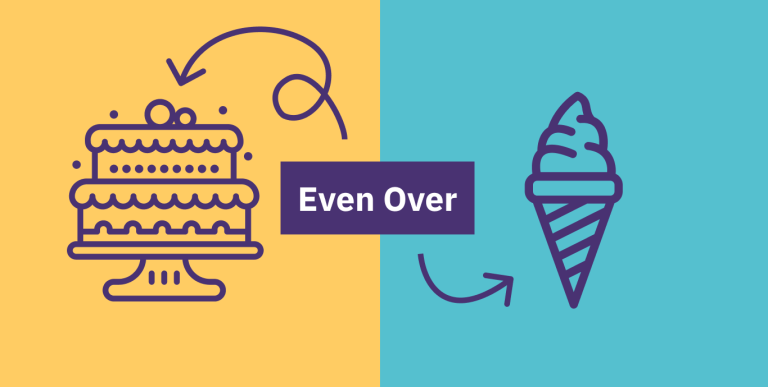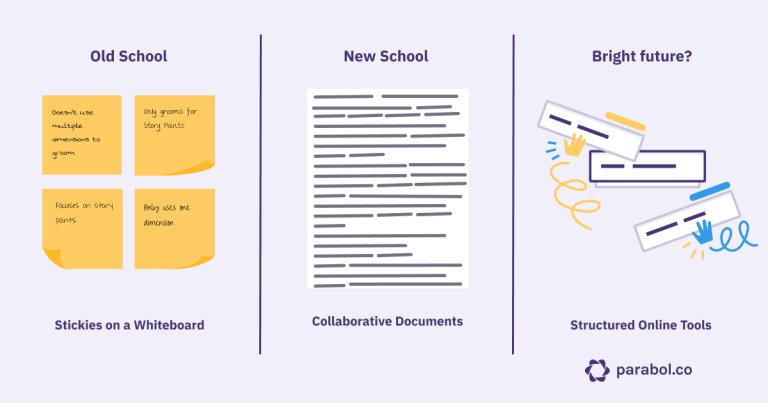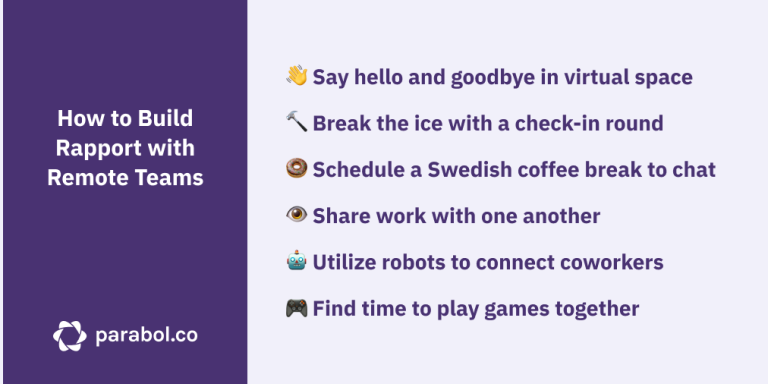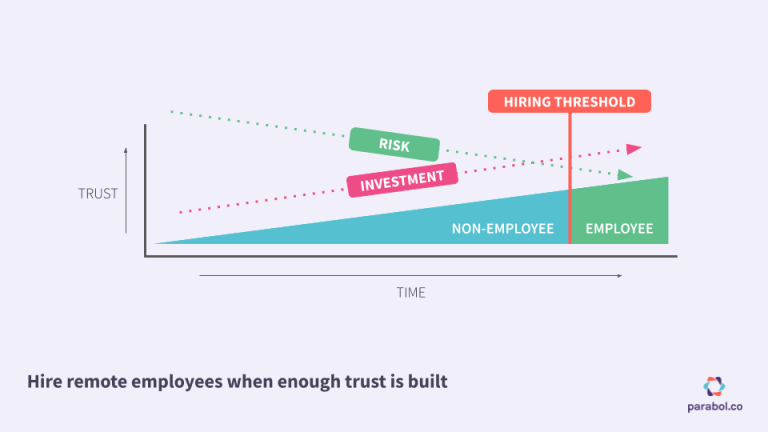PLG Sales: 7 Things I Learned to Improve My Close Rate

Traditional B2B sales is largely about convincing prospects they need your solution. Whenever I worked in traditional sales roles, I was trying to live out one of my favorite Jay-Z lines:
I sell ice in the winter, I sell fire in hell,
Jay-Z – U Don’t KnowI’m a hustler, baby, I’ll sell water to a whale
But selling people a thing they might not want or need is tough. I wasn’t as good as Jay Z. Most whales I encountered didn’t want more water.
When I got to Parabol, it felt like the B2B sales approach I knew had been tipped on its head. I entered the world of product-led growth, where the sales team only reaches out to people who are already actively using the product.
Hence the mouthful of a phrase, “product-led growth sales”, or PLG sales for short.
It meant saying goodbye to cringey LinkedIn cold outreach and a hello to spending my days talking to active users who love our product.
In my first year, there was a lot to learn. Here are some of my top tips for adjusting to PLG sales and closing more deals.
1. Walk softly but carry a big stick
You probably have the power to limit a prospect’s access to the tool they love. Don’t be afraid to responsibly use that leverage.
Our sales reps currently reach out to companies on our free plan that have a good number of active users and have been meeting consistently on Parabol for 3 consecutive months. People at that usage level tend to really like our product and don’t want to lose us. This affords us some wiggle room to start the sales conversation in an open, friendly, and low pressure way.
Our process is to ask for product feedback from several users and use those conversations to learn more about how their org works, what their buying process is, and who makes the decisions. The end goal of course is to agree on a fair price while getting the contract in front of the right person.
I’ve learned that users like having their voices heard and they appreciate that they get to influence the public roadmap of a product they use. The conversations tend to have good vibes when the end user is already won over to your product.
But the shadow side of all these kumbuya themed calls is that you can find yourself a month into the sales process with plenty of friends but without a contract. You have been all carrot (giving them things they want, such as product demos) and no stick (setting hard deadlines and sticking to them.)
I think every sales coaching call I had my first few months went something like this:
Drew: This deal is taking too long, they’re stringing me along.
Sales lead: Did you set a deadline?
Drew: Sort of.
Sales lead: What does that mean?
Drew: Okay I didn’t set one, but I do know the names of all their dogs and we had a ton of fun talking about how we like rooting against Tom Brady.
Sales lead: I suggest you set firmer deadlines.
Once I got comfortable telling people that while we were definitely friends but I still had to cut off their free usage at X date if they weren’t advancing the sales process, things went a lot better.
2. Learn to navigate the turns
Always ask for what you need, even if it interrupts the flow of the conversation.
Early on I’d find myself running out of time on my calls. I’d be vibing about TV shows and before I knew it our time would be up and I hadn’t asked them any questions about what their software purchase process looked like. While it was great to establish the relationship, I hadn’t moved the sales process forward.
A great part of doing PLG sales is that you’re talking to users who like the product and have insightful thoughts on how to improve it. But when you’ve framed the call as a “product feedback call” it can feel awkward to then start talking about how and when they might actually start paying you some money.
I struggled to find smooth transitions to that part of the call. Our sales leaders call this part, “making the turn.”
I improved at making the turn when I just kind of gave up on finding a good transition. I’d write on my sales notes template “ASK ABOUT THEIR PURCHASE PROCESS” and when I got to that section during a call I’d just do it.
To my great relief, almost everyone just rolls with it. It’s like you can build up a lot of goodwill by being non-salesy for 20 minutes and people respect that and are totally fine talking the nuts and bolts of a deal for a few minutes. I am sure my teammates all have their own ways of navigating the turn, and finding what works for you is definitely a key part of doing PLG sales well.
3. Don’t be afraid to create the playbook as you go
Running experiments helps the sales team be more efficient in the long run.
We have a standard PLG sales motion that works really well, but we are always looking for ways to improve. There aren’t that many established industry best practices from other PLG companies like Slack, Calendly, or Dropbox sales, which means we get to run all sorts of experiments and figure it out for ourselves.
Our sales team works in month-long sprints, which are geared around running small experiments every month and seeing what we learn. If an experiment is successful for our sales reps, we add it to our playbook.
Some recent experiments include trying to determine whether:
- Using visual data on product usage metrics in our first email impacts response rates
- Offering a digital gift card gets us more calls, faster
- Sending personalized videos impacts close rate
We also try to talk shop whenever we can with other PLG sales teams to pick up tricks and tips. We’ve had productive calls with folks at other SaaS companies like Notion and Figma about their sales motion and freemium models.
We still have a lot of open questions and it’ll be fun to craft experiments that get us answers.
This has been a difficult part of the Parabol sales culture to adopt. I am very much an “if it ain’t broke, don’t fix it” kinda person, and things have been working pretty well. But with time and coaching I’ve come to appreciate that if we want to hit our aggressive MRR goals, we need to keep getting better.
4. You can BYOT (bring your own title)
Being creative with the title you use can help open doors.
The sales team can call themselves whatever they think will get the job done. The one constant is that we avoid traditional enterprise sales titles like “Account Executive” and “Business Development Representative”. The product-qualified leads we reach out to are mostly people on development or product teams, including engineers and other technical folks who are notoriously wary of talking to salespeople. So we lean toward calling ourselves some version of a product manager.
We’ve worn the hats of product managers, associate product managers, growth product managers, and account managers. We’ve even toyed around with reaching out as security officers, here to help them secure their accounts and manage their users. That one feels like a bridge too far for me at the moment but hey, it’d make for a fun experiment!
5. Have stats on hand to back up your claims
Hard data is the most important thing to have on a PLG sales call.
PLG sales relies heavily on communicating usage metrics to the prospect. In our case, we let prospects know they have technically been using our product with more teams than are allowed on our free tier. Understandably, a lot of people immediately want to know more about who is using the product, when they use it, and what they use it for. And we can tell them all of that!
But only if you’ve done your research before the call. I quickly realized that I couldn’t just waltz on to a call and expect everyone to believe what I said. Especially because we count aggregate usage across entire companies. Often separate departments will be using us without any knowledge of each other meaning the numbers may not immediately track for our PQLs.
It’s super helpful to have any and all company data at your fingertips so you can reference specific information that supports the story you want to tell about their usage and activation.
6. Have empathy for those in kafkaesque bureaucracies
Don’t get frustrated by red tape, instead learn to help people navigate their own procurement process.
It’s not uncommon for me to talk to someone at a large organization who works with several teams that all use and love Parabol. But when I broach the subject of paying, they look like they’ve seen a ghost. They say that they would pay if it was up to them but it’s doubtful the deal moves forward. At first when this happened I would think:
“You work at MegaCorp! You have all the money in the world! Stop with these lies!”
But in reality they are just hamstrung by a system that doesn’t let individuals choose the tools they want. Often, they already have a deal in place for a tool no one likes. Or they only get a tool budget at certain times of the year. Or their legal and compliance teams take 6 months to review any purchase requests.
What unites all of these users is that they started using Parabol because we solved a problem. And the fact that we’re free allowed the prospect to fly under the radar. Making the partnership official changes all that.
These days when I encounter such folks I try to become a caring friend who will help them cut through the miles of red tape that have mummified their organization. Sometimes this means giving them a free trial of our full-featured enterprise plan so that they can prove to their boss that the team will use us more than their current tool.
Or I might set them up with a Parabol advocate from a different department who agreed to help them shoulder the load of getting approval. In some cases it helps to make custom collateral showing how Parabol will improve their bottom line.
In all cases it means a lot of patience and a ton of empathy.
7. Don’t forget your sales fundamentals
While there are many differences between a bottom-up and top-down sales motion, there are quite a few sales best practices I use on a daily basis.
For example:
- I try to set my next call while on the current call
- I maintain a consistent follow- up cadence
- I craft outreach sequences
- I act like a normal human, not a sales-script reading robot
PLG sales is its own unique beast, but that doesn’t mean the other stuff you done at other sales jobs is irrelevant.
PLG Sales: What’s in store for the future?
I expect we’ll continue to hone on our core sales process while also finding a ton of new ways to close more deals, faster, so we can ramp up our annual recurring revenue (ARR).
One thing I can say for sure is that I will spend zero time on low probability cold outreach just because some business intelligence algorithm has determined targets meet the ideal customer profile. And I have my job at a PLG sales company to thank for that.









